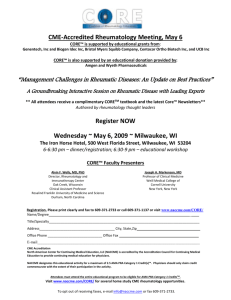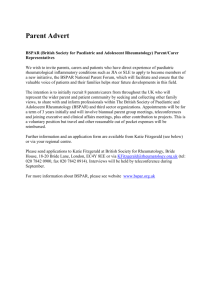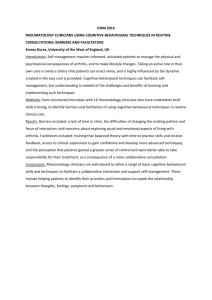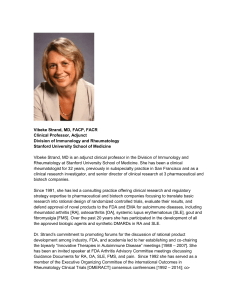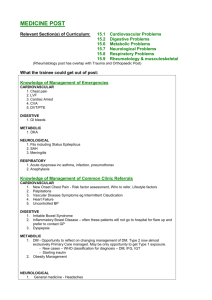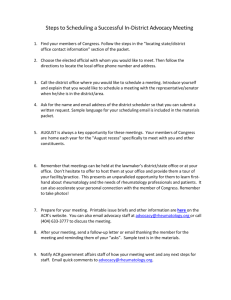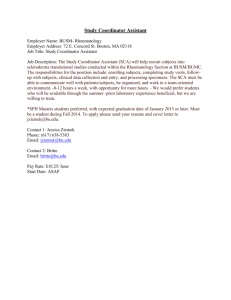Refer to Dr. Harsha Gunawardena - Parsons Heath Medical Practice
advertisement
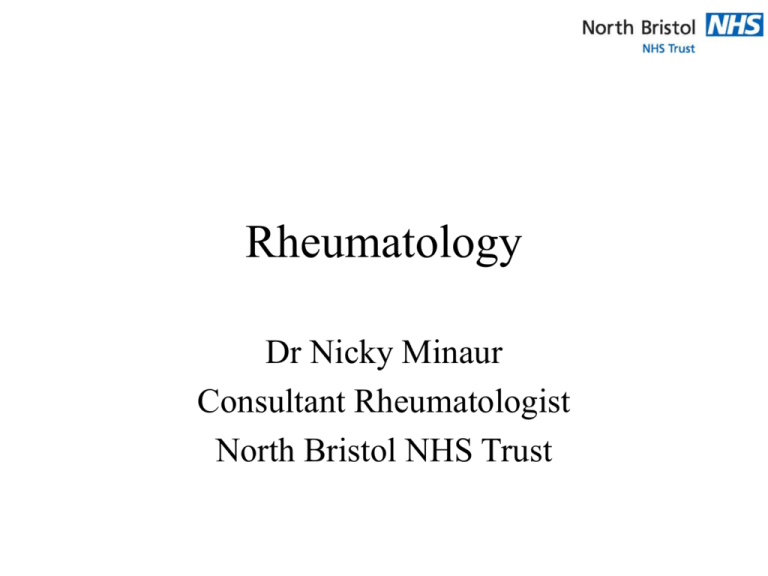
Rheumatology Dr Nicky Minaur Consultant Rheumatologist North Bristol NHS Trust Talk Outline • The local Rheumatology Service • A tale of two patients – opportunities and challenges • Recording biologic treatments in primary care • CTD pathway • Patients with chronic pain • Discussion Rheumatology in the Region • NBT (8 Consultants), UHB (4 Consultants), Weston (2 Consultants), Gloucester (5 Consultants) • In-patient beds for all Bristol & Weston patients on Trym Ward, Avon Orthopaedic Centre, Southmead • Number of beds is currently 9 reduced from 25 beds 10 years ago New hospital? Rheumatology Team at NBT • Clinics held at Southmead, Frenchay and Cossham Hospitals (Henshaw House) • 8 Consultants, 3 SpRs, 1 ST1/2 ward doctor • Specialist Nurses • Specialist Rheumatology Physiotherapy, Occupational Therapy, Psychologist • Orthotics Consultant Rheumatology Staff – all see inflammatory arthritis • Dr Peter Hollingworth – SMD- medicolegal • Dr Val Kyle – FHY, CSSHM- PMR/GCA, vasculitis • Dr Paul Creamer (Clinical Lead) – SMD, FHY, CSSHM- clinical research, ankylosing spondylitis, gout • Dr Sam Patel (Rheumatology/General Medicine) – FHY- MAU, Behçet’s syndrome, vasculitis Consultant Rheumatology Staff (contd) • Dr Nicky Minaur – SMD, CSSHM- modernisation, transition clinic for JIA • Prof Jon Tobias (previously UHB) – SMD- academic, osteoporosis, metabolic bone disease • Dr Emma Clark (Senior Lecturer) – SMD- academic, osteoporosis, hypermobility syndrome • Dr Harsha Gunawardena – SMD, CSSHM- connective tissue diseases, vasculitis Specialised & Combined Clinics • Specialised clinics for connective tissue diseases, osteoporosis, transition patients • Combined clinics with orthopaedics hands, upper limbs, hips, knees and feet • Combined clinics with dermatology, respiratory, neurology Request • Please don’t allow patients with inflammatory joint disease or connective tissue diseases (eg scleroderma) to go to an independent treatment centre for elective orthopaedic sugery • These patients need the specialised, multidisciplinary care available at NBT What’s new in Rheumatology? A Tale of Two Patients • Colin, now aged 71, developed RA 21 years ago • Stopped work age 50 due to RA • IM Gold, D-Penicillamine, SSZ, steroids • R TKR Patient 1 • • • • Lost to follow-up in the 1990’s Referred back 2005, on SSZ, active RA MTX, escalated, switched to S/C Assessed for anti-TNF, SOB++ on Etanercept - pulmonary fibrosis • Treated with Rituximab Feb/Mar 2009 Patient 2 • Jill developed RA aged 50 in 2010 • Off work with RA, also diagnosed with DM • Had been started on Prednisolone 15mg by GP before referral, CRP 92 • Seen first in June 09 • Started on MTX 15mg/wk, FA, Pred weaned • Referred Rheumatology PT, OT Patient 2 • Reviewed 1 month later July 09 • August 09 - SSZ added to MTX, now off steroids and diabetes resolved • Sep 09 – DAS28 6.29 (active RA), SSZ increased • Oct 09 – RSN – DAS28 5.86 (still active RA), MTX increased to 17.5mg/wk. Mood↓ Patient 2 • November 09 – DAS28 5.15, MTX increased to 20mg/wk, SSZ reduced to 1g bd • Reviewed 8 weeks later, Feb 10 - DAS28 3.1 • Reviewed April 10 – DAS28 2.1 • In remission after 8 visits and 10 months Differences • • • • Colin Never worked again Very disabled RA never really controlled • Comorbidities • Has had 2 different biologic agents • Jillian • RA under control within a year • Back at work • No disability • Diabetes gone • Self-managing RA, loosing weight Costs: standard vs aggressive 3 or 4 monthly visits for 20 years is 60-80 visits • Estimate 55 visits as lost for 2 years • Major joint surgery • 2 biologic agents • Benefits • Poor quality of life 8 visits in first 10 months • Estimate annual review for next 20 years • This is 28 visits • Additional visits as needed • In work, no disability Rheumatology in 1980 • NSAIDs were 1st line • Wait for erosions before starting treatment with a second-line drug • Use of IM Gold and D-Penicillamine still common Outcome of delayed, tentative treatment Rheumatology in 1990’s • Start DMARD as soon as diagnosis made-don’t wait for erosions- but there was often a 9 month wait from GP referral to Rheumatology appointment • Increasing use of Methotrexate and doses creeping up to 15mg/week or higher • Combination treatment eg MTX and SSZ shown to be effective in trials, not used much in practice Rheumatology in 2000’s • Methotrexate became thought of as the ‘anchor drug’ • S/C Methotrexate use increased, and doses increased- commence at 15mg/wk, max 2530mg/wk • Leflunomide introduced 2000 • Increasing use of combination Rx- MTX, SSZ, HCQ, Prednisolone Rheumatology in the 2000’s • Services changed with the NHS plan • Waiting times came down dramatically • Musculoskeletal interface services developed • Case-mix in rheumatology has changed as non-inflammatory conditions are not reviewed, and ‘simple’ conditions not seen Rheumatology in 2000’s • First RCT of anti-TNF therapy in RA was published in 1999 Infliximab (Maini & Feldman) • Many others followed • NICE has approved use of – – – – Infliximab, Etanercept (2002) Adalimumab (2007) Certolizumab (2010) Rituximab (2007) • In pipeline Tocilizumab and Golimumab……. ATTRACT Study 2004 MTX did not halt new erosions, especially in early RA (< 2years), but may slow their development compared to no treatment Infliximab does halt new erosions, even in early RA Anti-TNF is more effective in combination with MTX In clinical practice, 70% of patients are still on Rx with antiTNF and MTX after 1 year MTX is the comparator drug in all biologic trials now Standard care in 2010 • Patient may delay more than 3 months to see GP • GP may try NSAID or 2, occasionally start steroids, arrange x-rays hands and feet, do bloods (FBC, CRP, PV, RF) • GP then refers, using Choose and Book • Seen in rheumatology 6-9 weeks later, diagnosis made • Starts MTX, review 3 months Standard care in 2010 • 3 monthly reviews and MTX gradually increased, then SSZ added and/ or MTX changed to S/C injections, as necessary • After approx 2 years, if still active RA • Assessed for anti-TNF Timing needs to change How can we apply these tools in good time? NICE Clinical Guideline 79 • Rheumatoid Arthritis: the management of rheumatoid arthritis in adults • Issued February 2009 • Guidance is aspirational and will require a major shift in the way services are delivered Window of opportunity ‘Remission’ may be low disease activity, or drug-free remission. NB RA does not ‘burn out’. Referral for specialist treatment (NICE CG79) • Refer for specialist opinion any person with suspected persistent synovitis of undetermined cause. • Refer urgently if any of the following apply: − the small joints of the hands or feet are affected (squeeze MCPJs and MTPJs, should not hurt) − more than one joint is affected − there has been a delay of 3 months or longer between onset of symptoms and seeking medical advice. • Do not put off referring a patient with persistent synovitis to a specialist if the bloods and x-rays are normal- these tests can be normal in early RA • If symptoms have been present already for more than 3 months, reactive arthritis is unlikely and further delay affects outcome, so refer immediately Single joint pain – not NICE guidance • Should be referred to Rheumatology if inflammatory – Early morning stiffness > 30 minutes, or – Boggy swelling suggesting synovitis, or – Raised inflammatory markers eg PV/CRP • Any of these features is significant • Psoriatic arthritis often presents with a mono-arthritis- personal or FH of Psoriasis? Disease modifying agents (NICE CG79) • Offer a combination of disease-modifying antirheumatic drugs (DMARDs) in people with newly diagnosed active RA, (including methotrexate and at least one other DMARD, plus short-term glucocorticoids) as soon as possible, ideally within 3 months of the onset of persistent symptoms. • Start DMARD monotherapy in people with newly diagnosed RA for whom combination DMARD therapy is not appropriate. Disease modifying agents (NICE CG79) • Cautiously reduce drug doses to levels that maintain disease control in people with recentonset RA receiving combination DMARD therapy in whom disease has been controlled ie those who have gone into remissison. Monitoring disease (NICE CG79) – In people with recent-onset active RA measure: - C-reactive protein (CRP) - key components of disease activity – Do this monthly until disease controlled to level agreed with the person with RA • This implies treating to a target Disease Activity Score (DAS28)- composite outcome measure of tender joints, swollen joints, patient’s global assesment of their condition, and CRP • Please measure CRP rather than PV with monitoring bloods • Target should be agreed with the patient at the start of treatment by the rheumatologist • People’s expectations are low and they are often grateful for any reduction in symptoms DAS28 • Greater than 5.1 – high disease activity, threashold currently for biologic therapy, but may come down to 3.2 • Less than 3.2 – low disease activity • Less than 2.1 - remission The multidisciplinary team (NICE CG79) People with RA should have access to a named member of the multidisciplinary team who is responsible for coordinating their care. Person-centred care (NICE CG79) – Explain the risks and benefits of treatment options. – Offer the chance to discuss and agree care, respecting decisions made. – Offer verbal and written information to improve understanding and counter misconceptions. – Offer opportunities to take part in existing educational activities, including self-management programmes, to people who are interested. Dilemma • NICE - see early RA monthly until in remission, perhaps 912 visits over first 2 years • This should translate into 70% patients in remission rather than 30%- fewer for TNF • We all have clinics full of existing patients, many diagnosed and treated pre-biologic eracomplicated patients! • We are being asked to see all chronic disease patients less often Can we abandon all the longstanding pre-biologic patients? • No, we have a duty of care to these patients too • However, in established RA (> 2 yrs), usual review should be annual • Advice and sooner review available- telephone advice line (on handout) • Patient reps’ group view Recording biologic treatments in primary care • A recent audit at NBT found patients given Rituximab did not have it recorded in the GP medication lists, as hospital prescribed • Anti-TNF side effects – risk of severe infection, reactivation of TB & Hep B, worsening cardiac failure, multiple sclerosis, SLE-syndrome, if previous solid tumour increased risk of malignancy Rituximab- anti-B cell • 2 infusions given a month apart, and then re-treatment if needed- mean 9 months later • Effect on immune system long-lasting • Side effects- severe infections, reactivation of TB and Hep B, rare neurological side effects progressive multifocal leucoencephalopathy, migraine, urticaria Aid to ensure these medications are recorded in primary care • We propose to add a phrase to letters from the specialist nurses when patients start treatment with anti-TNF and Rituximab • Please add this treatment to the patient’s medication list, marked hospital-prescription only • Then if another GP or speciality sees the patient, they are aware of the biologic treatment • ? Likely to happen Directorate of Musculoskeletal Services Department of Rheumatology Symptoms of fever, weight loss, malaise, rash, arthritis, renal insufficiency, chronic sinusitis, unilateral headache, cough and/or SOB Constitutional symptoms, rash, photosensitivity, arthralgia/arthritis, Raynaud’s, alopecia, serositis, muscle weakness, skin tightening, SOB Clinically stable? History of recurrent miscarriages or unexplained thromboses Yes Consider infection or malignancy Negative ANA /ANCA Pre-clinic investigations: FBC, UE, LFT, PV, CK, ANA, urine dipstick, CXR, consider ANCA NO No other cause identified – still consider CTD / vasculitis Rheumatology SpR Southmead via Southmead switchboard or CTD Consultant Dr. Harsha Gunawardena 0117 3232175 (secretary) & 0117 323 5289 (fax) 0117 9505050 ext: 2615 (office) Mobile via NBT switchboard Email: harsha.gunawardena@nbt.nhs.uk (Positive ANA /ANCA) Clinically stable? Yes NO Refer to Dr. Harsha Gunawardena - CTD clinic (Southmead / Cossham) via Choose and Book Osteoporosis • Open access DXA if amber risk on www.sheffield.ac.uk/FRAX • Refer complex or severe OP to Prof Tobias’ osteoporosis clinic • Rachel Lewis (rheum physio) can do lunchtime meetings for interested practices talking about the physiotherapy service for osteoporosis and hypermobility syndrome Patients with widespread chronic pain- ? fibromyalgia • Handout suggesting some blood tests and conditions to consider • Coeliac disease • Hypermobility syndrome Benign joint hypermobility syndrome Rheumatology physio can help with postural and core stability, or, refer rheumatology (Dr Emma Clark). • Thanks for listening • Any Questions or Comments? • nicola.minaur@nbt.nhs.uk
